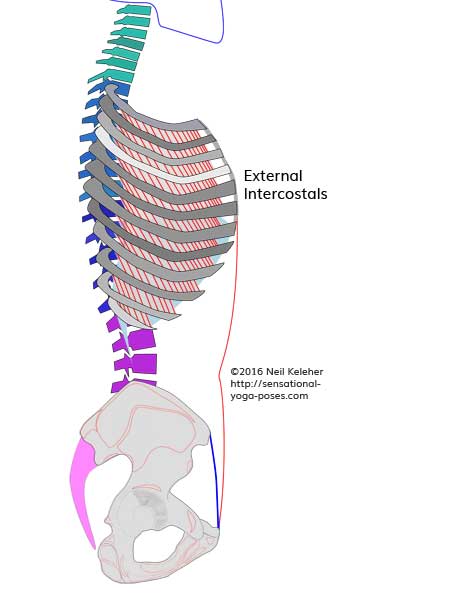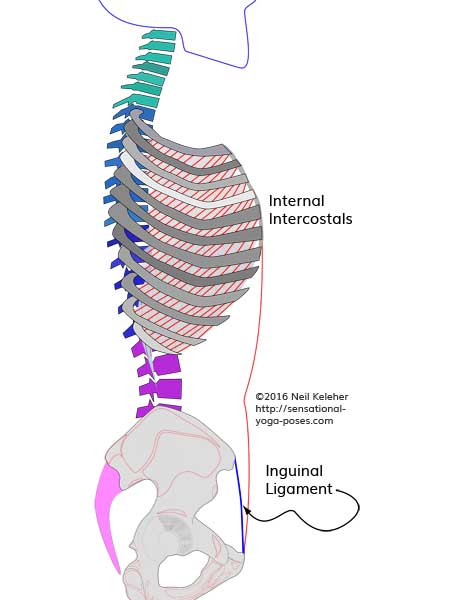Intercostal Muscles
Feeling and Controlling Them for
Better Ribcage Mobility and Control
The intercostal muscles are the primary key to greater ribcage awareness and control.
Along with the spinal erectors, Levator Costarum, serratus posterior inferior (and superior), these muscles help to move the ribcage or stabilize it.
However, of all of these muscles:
- The intercostal muscles are the ones that help you to directly feel your ribcage.
- They can help you better feel your ribs and control them.
The Two Main Intercostal Layers
There are two main layers of intercostal muscles.
- The external layer angles forwards and downwards between neighbouring pairs of ribs.
- The internal layer has fibers that angle forwards and upwards.
The Intercostal Muscles in Context
The intercostals are positioned between adjacent ribs and move the ribs relative to each other. So, to give the intercostals some context, here's a quick look at the ribs and the thoracic spine.
The Ribcage and Thoracic Spine
The ribs attach to the thoracic spine and in the case of the upper 7 pair of ribs, directly to the sternum.
Actual movement of the ribs relative to each other and the thoracic spine is quite limited if the thoracic spine is kept still. If the thoracic spine is kept still and you try lifting and lowering your ribs, the amount of movement is perceptible but very small. As a result, the breath that results from just using the intercostals is quite shallow.
However, if you include bending movements of the thoracic spine (particularly backbending the spine with lifting the fronts of the ribs and forward bending the spine with dropping the fronts of the ribs,) then the movements of the ribs can be quite large and much more meaningful in terms of proprioception. It can also make costal breathing, or perhaps more accurately costo-thoracic breathing quite a bit deeper.
(I'm not sure if there is such a term as costo-thoracic but it's meant to capture the idea of the ribs and thoracic spine move together.)
The Upper and Lower Ribcage and Thoracic Spine
The ribcage and thoracic spine can be divided into an upper and lower part.
Because the upper 7 ribs attach to the sternum, movements of the upper ribcage can be a bit more challenging to learn than movements of the lower ribcage.
- The upper ribcage includes the upper 7 thoracic vertebrae and upper 7 pairs of ribs.
- The upper ribcage corresponds roughly, to the part at the back covered by the shoulder blades.
- The lower ribcage includes the lower 5 thoracic vertebrae and the lower 7 pairs of ribs.
- The lower ribcage corresponds to the arch of the ribcage below the sternum.
The Sternum Adds Stiffness
One of the reasons for the sternum is to make the upper ribcage more rigid and so give the muscles that move and control the shoulder blades and arms relative to the ribs a firmer foundation from which to act.
As examples of this,
- a snake skeleton shows no sternum, which makes sense since it doesn't have arms.
- an ostritch skeleton, because of large wings has a very thick sternum.
- Turtles may have developed shells to give their forelimbs a stable base for digging.
Because of the sternum, bending and twisting the upper ribcage can be difficult.
Movement Possibilities of the Ribcage and Thoracic Spine
Movements possibilities for the ribcage (which includes the ribs and the thoracic spine) include:
- backbending,
- front bending,
- side bending and
- twisting.
S-bending the Spine
More complex movements can include s-bending the spine.
Using the pelvis as a base for the obliques (and in this case modelling the obliques as similiar in purpose to the intercostals), movements of the ribcage relative to the pelvis include sliding the ribcage leftwards and rightwards and also frontwards to rearwards.
These latter movements can involve an s-bending action of the spine to keep the ribcage relatively upright as it is "translated" or slid relative to the pelvis.
I first encountered it in dance classes. In that context, these movements might be called "ribcage isolations".)
Further movements of the ribcage include lifting only one side of the ribcage while keeping the other side relatively still.
Possible movement combinations include:
- Sliding the ribcage (forwards, backwards or to either side) and lifting either the front ribs, back ribs, or left or right ribs.
- Twisting the ribcage and while holding the twist sliding the ribcage (forwards, backwards, or left or right), lifting the ribs (front, back or sides of the ribs) and/or bending the thoracic spine (forwards, backwards, left or right.)
For reasonably complete ribcage and thoracic spine control it helps to be able to feel and control (in isolation) the thoracic spinal erectors, the intercostals and the the levator costalis. It may also help to have control of all three bands of the transverse abdominis. Respiratory Diaphragm awareness can help so that you can sense if your diaphragm is active or not.
I'll assume you already can feel and control your spinal erectors. If not the spinal erectors article covers some exercises for learning to feel them.
In addition practice isolating your lumbar, thoracic and cervical spinal erectors. I'd suggest learning to back bend and forward bend your lumbar spine in isolation as well as your lower thoracic spine, the upper thoracic spine and your cervical spine.
For Sacroiliac and thoraco-lumbar integrity, also practice moving these parts in isolation as well as when integrated into fuller movements of the spine.
In each case, back bending in isolation involves feeling the spinal erectors activating as you bend the isolated part of the spine backwards. A good indication that you are also activating your smaller spinal muscles is being able to feel each vertebraa in a backwards bend.
Focusing On Your Front Ribs
Using a thoracic back bend, and bending it backwards from the bottom upwards while either sitting or standing, focus on feeling the fronts of your ribs lifting. Here the focus is on using the thoracic spinal erectors.
To activate your intercostals focus on feeling your front ribs and lifting them higher as you bend your spine backwards. Sink your ribs down as you bend your thoracic forwards. You could interpret the sensation as expanding and then contracting the front of your ribcage.
Note that when bending your spine forwards you could do it as a relaxed action while standing or sitting, letting gravity pull your ribs down, or as an active action, using your intercostals to help pull your ribs down.
Feeling Your Side Ribs
Once you have a feeling for the fronts of your ribs lifting and lower, move your awareness to your side ribs.
Your bottom side ribs will tend to move outwards and inwards with minimal movements of your thoracic spine. You may find it easier to feel your side ribs if, while standing you reach one arm up.
- Lift the shoulder, then the ribs so that you reach your hand as high as possible.
- Relax and repeat keeping the arm lifted when you relax.
- Focus on feeling your shoulder and your ribs.
- Then repeat the exercise with the arm down.
- See if you can lift your ribs without lifting your shoulder.
Feeling Your Back Ribs
Once you can do that then move to your back ribs. Try to turn "lifting your side ribs" into "lifting your back ribs. You may find that you bend your thoracic spine forwards in order to do this.
Levator Costalis
An option which activates and use the Levator Costarum is to bend your thoracic spine backwards, feel your spinal erectors activating, and then try to lift your back ribs.
Imagine using the contraction of your spine erectors to lift your back ribs. The levator costalis located beneath the spinal erectors and so the sensations of both can be easy to mix up.
An exercise you can then try is lifting all four sides of the ribcage together. Or lift the side ribs, then the back ribs then the front.
Another option is to lift the ribs on only one side.
Published: 2017 04 17
Updated: 2020 08 27




